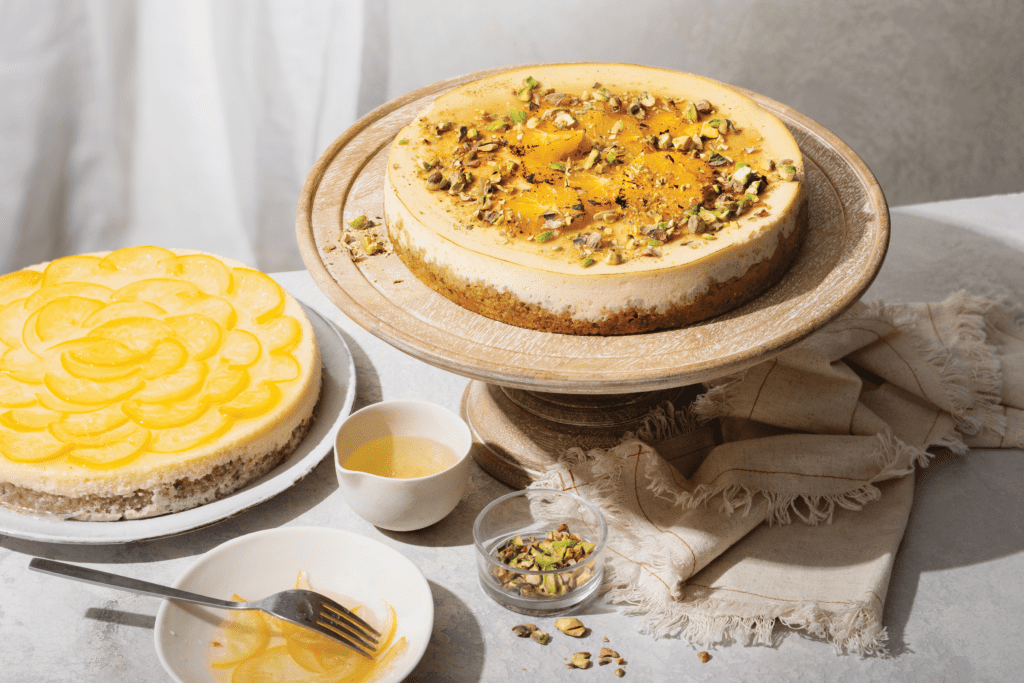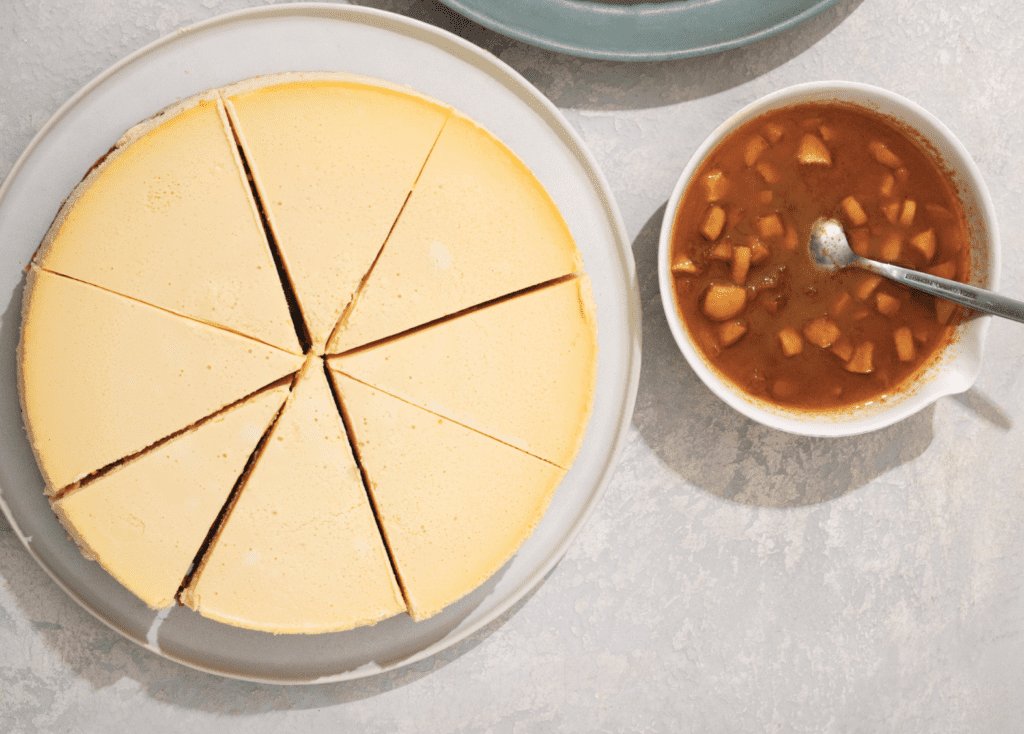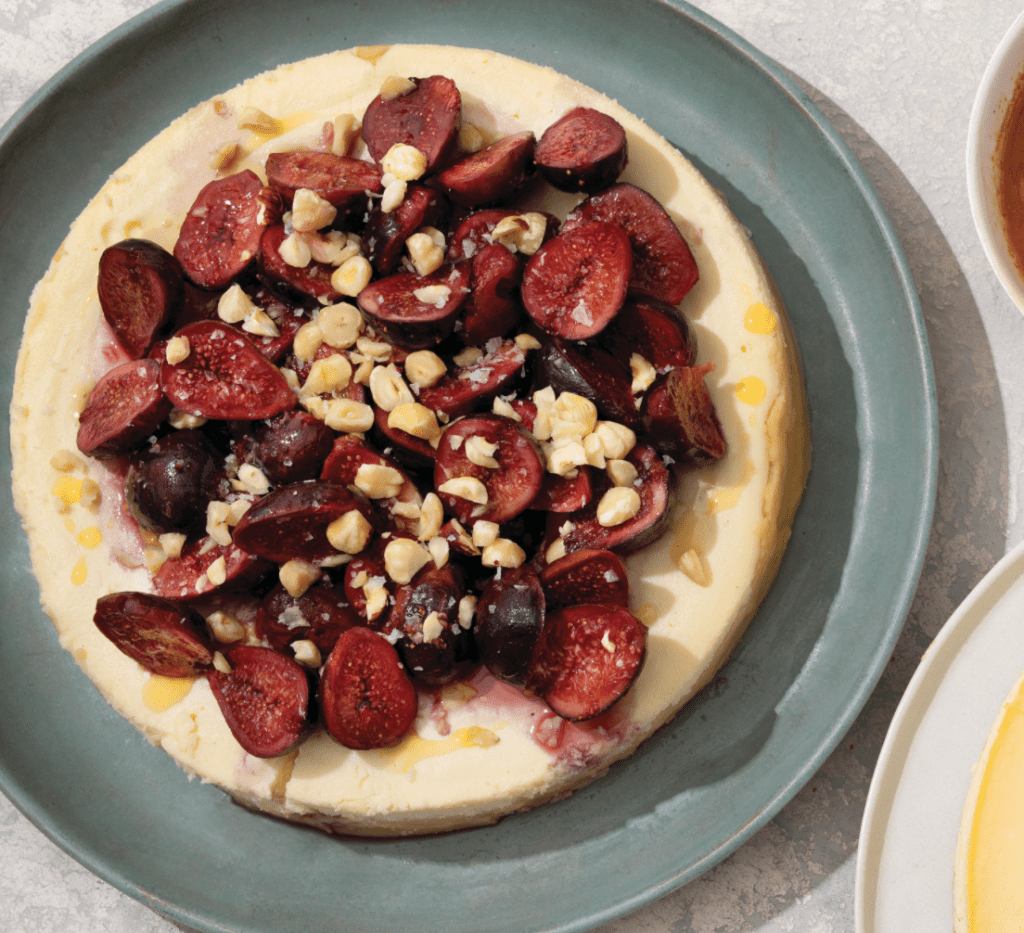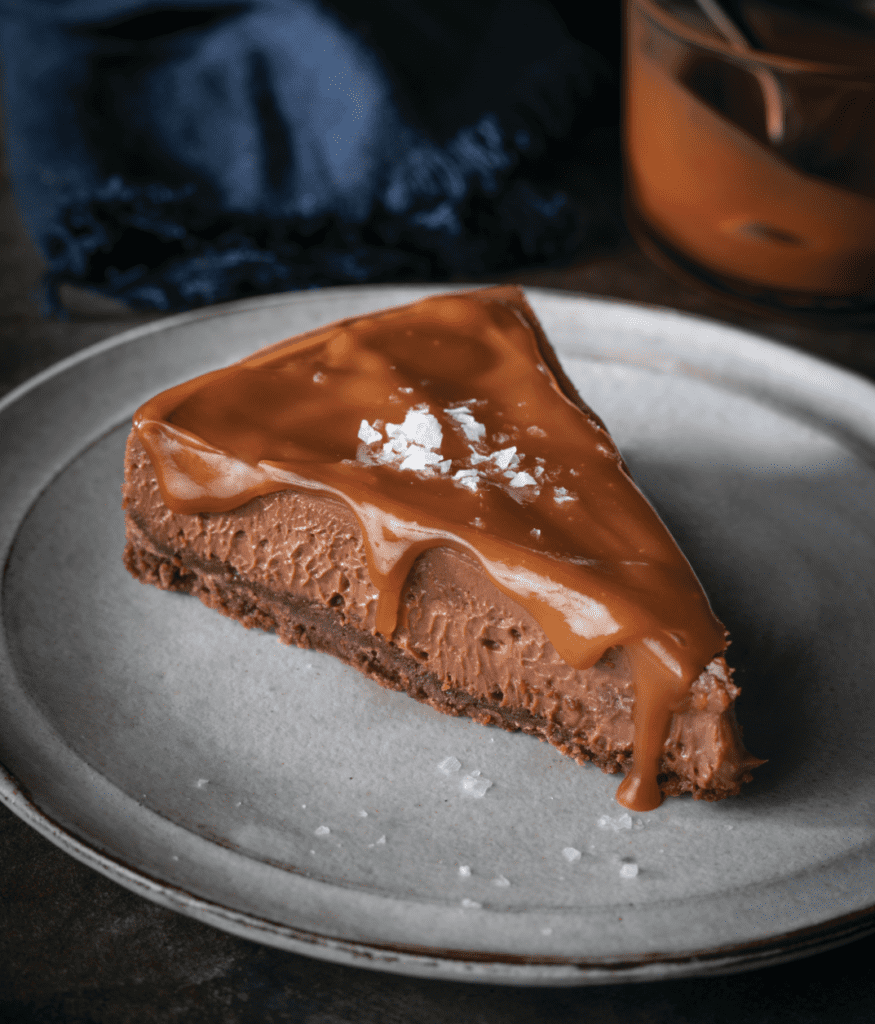
Photographed by Adam DeTour; Styled by Catrine Kelty
My great aunt would make an unapologetically classic New York-style cheesecake every Passover, with a matzo meal crust, and we’d eat it in the basement of her house in Flushing, Queens, where we had the second Seder every year. It’s not a traditional Passover dessert, but I’d anticipate it longingly, and the lengthy prayers and songs would test my patience. The silky, gently baked slice of cool dairy sweetness was a magical, perfect finish to the meal. I’d lick the tines of my fork—hoping my great uncle would slide me a second sliver—and wonder what the secret was.
Years later, my great aunt nonchalantly confessed to me it was just the recipe from the back of the cream cheese box, but there’s something comforting in that confession. It was not some guarded family secret passed down from ancestors like I’d imagined, but something accessible. As a chef who has spent years creating composed desserts, I’ve realized we don’t need much to be indulged. Cheesecake is dairy, eggs, sugar, and not much else. A dessert that is no mystery but satisfies so much—creamy, tart, cool, and just the right amount of sweet.
Due to its simplicity and versatility, I believe that cheesecake, in all its variations, is one of the world’s most perfect kinds of cakes—standing beautifully alone or becoming a delicious canvas for seasonal fruit, nuts, and sauces. And it is so much more than cream cheese. If you take a dive into cheesecake, you’ll quickly learn there are many interpretations and styles, vast variations and beloved classics across cultures. These recipes are just a few possibilities, but I hope they inspire you to explore and indulge in the dreamy dairy dessert with which I’ve had a lifelong love affair.
Burnt Honey and Yogurt Cheesecake with Vanilla, Orange, and Pistachios
For this yogurt cheesecake, I was directly inspired by the dreamy, uplifting flavors used by cooks from Sicily to Lebanon and beyond. You can mix this cake completely by hand, but a quick buzz with an immersion blender emulsifies the eggs, giving it an impossibly silky texture. A culinary torch is helpful for the final step.
The best types of dairy for cheesecake:
Cultured dairy products and softer, fresh cheeses are delicious ways to branch out and get creative with your cheesecake adventures. Some cheeses can stand alone, and others work well blended together with cream, cream cheese, sour cream, or yogurt.
My favorites include:
- Fresh goat’s cheese
- Ricotta
- Greek yogurt
- Labneh
- Mascarpone
- Sour cream
- Fromage Blanc
- Quark
- Crème fraîche
Chèvre Cheesecake with Candied Meyer Lemon
I’ve had some version of this cheesecake on almost every menu since my first pastry chef position in 2013. It’s incredibly versatile and pairs beautifully with most fruit, so feel free to switch it up seasonally. I like it with candied citrus in the winter, poached rhubarb and macerated strawberries in the spring, grilled peaches in summer, and apples or quince in the fall. If you can’t find Meyer lemons, conventional will work, too.
Tips
Cheesecake can intimidate, but by following simple guidelines, yours can be flawless. Here are a few rules I stand by for a successful, silky bake each time:
- Always work with room temperature dairy and eggs, taking them out of the fridge a few hours before you want to mix the filling. It will be much easier to incorporate everything together and prevent lumps from forming during the mixing process.
- Use a water bath. Wrap the bottom of the pan in foil in case the spring-form seal isn’t 100-percent tight and place it on a sheet pan or roasting pan with a good rim. I like to add hot water once the pan and cake are already in the oven, filling the pan up about ¾ of the way. It won’t look like much, but the steam will help keep the cake from cracking and ensure a creamy texture all the way through.
- Bake at a low temperature, for a looooong time. I bake these cakes at 300 degrees, max. It may take more time, but cheesecake batters are delicate and can’t take the higher heat. Be patient. I tested these recipes multiple times in both state-of-the-art professional ovens (with the ability to adjust for humidity and fan speed) and the most basic of home ovens with nothing more than a thermostat. The differences were astounding (from 45 minutes to two hours) and it goes to show how varied ovens can be. I’ve used the home-oven bake times for these recipes, but keep in mind the wide range of home ovens too. You’ll have to get comfortable with checking the cheesecake and letting them go a little longer if needed.
- Look for the wobble. You want to take the cheesecake out of the oven once it’s set on top, but still a little wobbly. That cook-over time as it cools plus an overnight rest in the fridge will bring it to the perfect, creamy texture. Baking too much past the wobble stage will result in the eggs over cooking and becoming grainy. My favorite way to test this is by very gently touching the top of the cheesecake in the center. If the batter is wet and a little bit sticks to my fingertip, it needs more time. If it just wobbles and bounces back, but my fingertip comes away clean, it’s good to go.
- Allow the cake to cool at room temperature fully before transferring to the fridge to chill. Sudden temperature changes can cause cracks, so let it hang out on your countertop a good while before chilling. Then, ideally, chill your cheesecake overnight so it has time to set. I find this allows for the best texture.
- Invest in a non-stick springform pan; they are budget friendly and will help you make and serve beautiful cakes every time.
- A stand mixer or a food processor are highly recommended for some of these cheesecakes, but handheld beaters or a strong arm will do as well.
Maple Cheesecake with Ginger Crust and Butterscotch Bourbon Apples
The warm flavors in this cheesecake are highly craveable and perfect for the colder months, making it an ideal winter dessert. The batter utilizes regular cream cheese, and if you can find a locally made one, that’s even better. Dark maple syrup is crucial here. The filling can be made a day ahead of time, chilled overnight and then poured directly into a room temperature crust to bake.
Ricotta Cheesecake with Red Wine Soaked Figs, Hazelnuts, and Olive Oil Crust
The first time I made a ricotta cheesecake I was so smitten with its simplicity. The filling is as basic as it gets, so you’re going to want to shell out for the good stuff here—anything that’s made fresh and locally is your best bet. The red wine-soaked figs are a bacchanalian luxury; along with toasted hazelnuts and a little drizzle of good olive oil—I’m transported to a Tuscan villa. If fresh figs aren’t available, use good quality dried figs and allow them to soak overnight.
Dark Chocolate Cheesecake with Caramel and Sea Salt
This cake has such a luxurious mouth feel that it’s more like to chocolate mousse than what we think of as cheesecake. The combination of cream cheese and sour cream make it silky smooth, and the gooey salted caramel topping and creamy interior gives way to a chocolate cookie-like crust with a satisfying crunch. Use good-quality 60-percent cacao or higher dark chocolate for this showstopper that’s a perfect end to a celebratory meal. Extra caramel sauce will keep in the refrigerator for up to four weeks.









